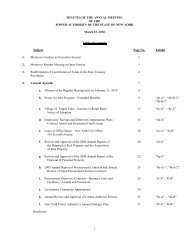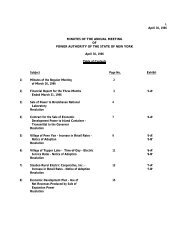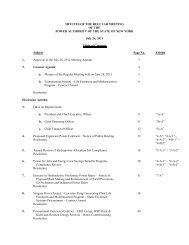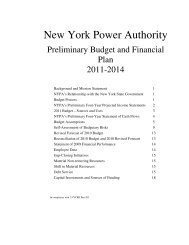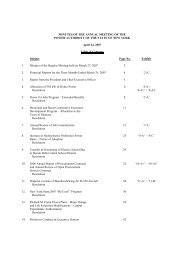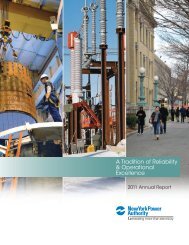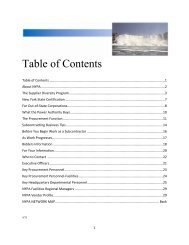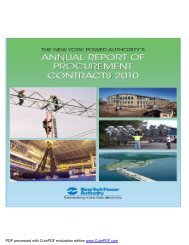nypa board of trustees from - New York Power Authority
nypa board of trustees from - New York Power Authority
nypa board of trustees from - New York Power Authority
You also want an ePaper? Increase the reach of your titles
YUMPU automatically turns print PDFs into web optimized ePapers that Google loves.
123 Main Street<br />
White Plains, NY 10601-3170<br />
914.681.6621<br />
914.681-6804 (Fax)<br />
Gil.Quiniones@<strong>nypa</strong>.gov<br />
Exhibit “5-B”<br />
Gil C. Quiniones<br />
Chief Operating Officer<br />
TO:<br />
FROM:<br />
NYPA BOARD OF TRUSTEES<br />
GIL C. QUINIONES, CHIEF OPERATING OFFICER<br />
DATE: SEPTEMBER 28, 2010<br />
SUBJECT:<br />
MONTHLY REPORT FOR THE BOARD OF TRUSTEES<br />
******************************************************************************<br />
This report includes highlights <strong>from</strong> the Operations Group over July and August. The<br />
highlight <strong>of</strong> the period was that the Flynn Plant, which had been shut down for a maintenance<br />
outage in May, was returned to service on August 7.<br />
<strong>Power</strong> Supply<br />
Plant Performance<br />
Systemwide net generation 1 in July was 2,094,787 megawatt-hours 2 (MWh), compared to<br />
projected net generation <strong>of</strong> 2,172,486 MWh. In August, systemwide net generation was<br />
2,065,665 MWh compared to projected net generation <strong>of</strong> 2,116,198 MWh in August. For the<br />
year, actual net generation is 16,278,297 MWh, which is below the year-to-date net generation<br />
target <strong>of</strong> 17,085,463 MWh, primarily due to low water levels on the Niagara and St. Lawrence<br />
rivers.<br />
The fleet availability factor 3 was 96.7 percent during July, 98.9 percent during August,<br />
and is 94.7 percent for the year. The generation market readiness factor 4 was 99.6 percent in<br />
July, which was above the monthly target <strong>of</strong> 99.4 percent, and 100 percent in August, also above<br />
the monthly target. For the year, generation market readiness is 99.8 percent.<br />
There was one significant unplanned generation event 5 in July – the Hell Gate Plant was<br />
out <strong>of</strong> service for two weeks due to a failed pothead 6 , resulting in a lost opportunity cost <strong>of</strong> $0.17<br />
million. The total lost opportunity cost <strong>of</strong> all unscheduled outages 7 in July was less than $0.20<br />
million, compared with generation revenue <strong>of</strong> $223.7 million. There were no significant<br />
unplanned generation events in August, and the total lost opportunity cost <strong>of</strong> all unscheduled<br />
outages in August was also less than $0.20 million, compared with generation revenue <strong>of</strong> $193.2<br />
-1-
million. The year-to-date lost opportunity cost is $0.51 million compared to generation revenue<br />
<strong>of</strong> $1,350 million.<br />
River flows at the Niagara project were below historical averages in July and August, and<br />
are forecasted to be well below normal for the next several months due to low precipitation in the<br />
Great Lakes Basin that has continued since December 2009. At the St. Lawrence-FDR project,<br />
flows were below forecast in July and August and are expected to be below historical averages<br />
for the rest <strong>of</strong> the year.<br />
The Flynn Plant was returned to service on August 7. It had been shut down for a<br />
maintenance outage 8 on May 7 due to problems with the combustion turbine generator rotor 9 .<br />
The event was considered a maintenance outage by the <strong>New</strong> <strong>York</strong> Independent System<br />
Operator 10 (NYISO) because the unit was removed <strong>from</strong> service upon approval <strong>of</strong> the system<br />
operator and did not fail while in-service. Siemens and NYPA are currently engaged in<br />
extensive technical analysis to determine the root cause <strong>of</strong> the rotor failure. The estimated<br />
revenue impact to NYPA is a loss ranging between $8 million to $9 million, spread over 2011 –<br />
2012. Repair expenses are estimated to be about $3 million, <strong>of</strong> which $2.3 million will be capital<br />
costs.<br />
Transmission Performance<br />
Transmission reliability 11 in July was 99.44 percent, which was above the target <strong>of</strong> 98.70<br />
percent, and 98.96 percent in August, which was below the target <strong>of</strong> 99.81 percent. The year-todate<br />
actual reliability is 95.79 percent, below the target <strong>of</strong> 96.41 percent. Performance has been<br />
affected by some outages not anticipated in 2010, several forced outages 12 , and some scheduled<br />
outages 13 that have taken longer than expected.<br />
There were three forced outages in July for a total <strong>of</strong> 373 hours. One outage was a<br />
significant unplanned transmission event 14 . The Marcy Capacitor Bank #2 was out <strong>of</strong> service for<br />
370 hours due to catastrophic equipment failure; the cause is yet to be determined but under<br />
investigation. The Massena-Utica and Massena-Chateauguay lines were out <strong>of</strong> service for 1.5<br />
hours each due to circuit breaker failure at Marcy.<br />
There were two significant unplanned transmission events in August for a total <strong>of</strong> 40<br />
hours. The Massena-Utica line was out <strong>of</strong> service for 25 hours and the Massena-Chateauguay<br />
lines was out for 15 hours, both due to line emergencies when a disconnect switch 15 did not close<br />
correctly and failed. The switch was repaired and the lines were restored to service.<br />
Life Extension and Modernization Programs<br />
On September 21, the 13 th <strong>of</strong> the 16 units at the St. Lawrence-FDR project was returned<br />
to service, as part <strong>of</strong> the project’s Life Extension and Modernization 16 (LEM) program. As<br />
reported in the June COO Report, the unit’s original return to service date <strong>of</strong> July 30 was delayed<br />
as the result <strong>of</strong> conditions not encountered with any <strong>of</strong> the previous 12 units including deficient<br />
original manufacturing <strong>of</strong> parts that require upgrading as well as other issues. The 2013<br />
scheduled completion date for the LEM project remains unchanged.<br />
-2-
Transmission Initiative<br />
NYPA is continuing to work with National Grid, Con Edison, and the Long Island <strong>Power</strong><br />
<strong>Authority</strong> (LIPA), regarding a proposed transmission line that would deliver power <strong>from</strong> Canada<br />
and upstate renewable energy projects to <strong>New</strong> <strong>York</strong> City.<br />
In July, PA Consulting briefed senior management at NYPA and National Grid on its<br />
draft analysis comparing load-weighted zonal electricity prices, productions costs, generator<br />
costs, and emissions in the Base Case and the Transmission Initiative Case. Subsequently, PA<br />
prepared sensitivity analyses considering several scenarios including Hudson Transmission<br />
Partners’ proposed PJM-NYC line, a range <strong>of</strong> natural gas prices, and 400 MW <strong>of</strong> <strong>of</strong>f-shore wind.<br />
Results indicated a net benefit in state-wide production costs and a reduction <strong>of</strong> emissions with<br />
the construction <strong>of</strong> the Transmission Initiative. A presentation <strong>of</strong> the sensitivity analyses was<br />
made to Con Edison and LIPA staff in July. Representatives <strong>from</strong> Con Edison and LIPA<br />
accepted the analyses, and Con Edison agreed to an executive-level meeting between NYPA,<br />
National Grid, Con Edison and LIPA to further discuss the Transmission Initiative. The<br />
meeting is anticipated for October.<br />
SUNY-Canton Project<br />
NYPA is working with the State University <strong>of</strong> <strong>New</strong> <strong>York</strong> at Canton (SUNY-Canton) on<br />
assessing options to relocate the section <strong>of</strong> the Moses-Adirondack 17 line on their campus to<br />
accommodate athletic fields. In July, NYPA and Commonwealth Associates presented SUNY-<br />
Canton an interim report on routing options. Commonwealth Associates was asked to research<br />
additional costs <strong>of</strong> the routing options and prepare a new report, which will be presented to<br />
Senior Management with staff recommendations in October.<br />
Blenheim-Gilboa Project Relicensing<br />
The Trustees will be briefed in September and October on the relicensing process for the<br />
Blenheim-Gilboa Pumped Storage <strong>Power</strong> Project. It is anticipated that by the end <strong>of</strong> 2010, the<br />
Trustees will be requested to authorize the start <strong>of</strong> this relicensing effort and a capital budget in<br />
preparation for relicensing. The Trustees will also be asked to approve an award <strong>of</strong> a contract for<br />
the development and implementation <strong>of</strong> a comprehensive information management system to<br />
support the relicensing effort.<br />
The Federal Energy Regulatory Commission 18 (FERC) license for Blenheim-Gilboa<br />
expires in April 2019. It is anticipated that, as with the relicensing efforts for the St. Lawrence-<br />
FDR and Niagara projects – which required seven to nine years and involved extensive studies as<br />
well as significant participation by and negotiation with stakeholders – there will be two phases<br />
<strong>of</strong> work for obtaining a new license for Blenheim-Gilboa. The first phase will involve<br />
preparation for relicensing and the second phase will be the formal FERC relicensing process.<br />
Preparation for relicensing includes preparing the necessary relicensing documents to begin the<br />
formal relicensing process in 2013.<br />
-3-
Organizational Realignment<br />
The assessment <strong>of</strong> potential operational interfaces between the <strong>Power</strong> Generation and<br />
Transmission groups has been issued and is being reviewed internally. A presentation <strong>of</strong> the<br />
results <strong>of</strong> the study will be made to the COO and the EVP <strong>of</strong> <strong>Power</strong> Supply in September. The<br />
final report is now scheduled to be completed in the fourth quarter <strong>of</strong> 2010.<br />
Smart Grid Demonstration Transmission Project<br />
In July, NYPA and the Electric <strong>Power</strong> Research Institute 19 (EPRI) signed an agreement<br />
and held a kick-<strong>of</strong>f meeting to organize the project implementation plan <strong>of</strong> a project funded in<br />
part through an award <strong>from</strong> the American Recovery and Reinvestment Act for its proposed<br />
“Evaluation <strong>of</strong> Instrumentation and Dynamic Thermal Ratings for Overhead Lines”, a Smart<br />
Grid Demonstration Project. The project will evaluate a suite <strong>of</strong> emerging technologies and<br />
applications that measure dynamic thermal capacity ratings 20 <strong>of</strong> overhead transmission lines, and<br />
NYPA will test a hypothesis that higher wind speeds, which generate more wind power,<br />
simultaneously cool transmission lines and thereby increase their capability to deliver power.<br />
EPRI issued purchase orders for the equipment, which is scheduled to be installed by NYPA<br />
later this year, followed by a two-year data collection and analyses project period.<br />
Environmental<br />
There were two environmental events in July. At the Poletti <strong>Power</strong> Project, a previously<br />
unidentified release <strong>of</strong> oil was discovered while excavating for a replacement potable water line.<br />
At the Hell Gate Plant, approximately 15 gallons <strong>of</strong> cable oil was released <strong>from</strong> the failed<br />
pothead that caused the unit to be placed out <strong>of</strong> service.<br />
There was one environmental event in August. At the Gregory B. Jarvis Small Hydro<br />
facility, a loss <strong>of</strong> power at the sump pumps resulted in minor flooding. When power was<br />
restored to the sump pumps, a quart <strong>of</strong> oil was released, resulting in an oil sheen on the surface<br />
<strong>of</strong> Canada Creek. Spill response measures were initiated and the released oil was recovered.<br />
The total year-to-date number <strong>of</strong> recordable environmental incidents is 18. The 2010<br />
maximum target for recordable environmental incidents is 25.<br />
Technical Compliance – NERC Reliability Standards<br />
As discussed in March’s COO report, NYPA reported potential non-compliance and<br />
submitted mitigation plans to the Northeast <strong>Power</strong> Coordinating Council 21 (NPCC) for two<br />
standards that apply to facility ratings methodology 22 and data for NYPA’s generation and<br />
transmission assets, and two standards that apply to NYPA’s Critical Infrastructure Protection 23<br />
program. All three <strong>of</strong> these standards are in the North American Electric Reliability Council’s 24<br />
(NERC) top ten <strong>of</strong> the most violated standards in the industry. NYPA continued to engage with<br />
NPCC in July regarding the six mitigation plans associated with these self reports. By the end <strong>of</strong><br />
July, NPCC approved all six mitigation plans and submitted them to NERC for approval, and by<br />
the end <strong>of</strong> August NERC approved the plans and submitted them to FERC.<br />
-4-
On July 2, NYPA reported five additional potential violations <strong>of</strong> standards that apply to<br />
NYPA’s Critical Infrastructure Protection (CIP) program. These relate to the “Physical Security<br />
<strong>of</strong> Critical Cyber Assets” (CIP-006) and the “Cyber Security – Systems Security Management”<br />
(CIP-007) standards. Mitigation plans for these self reports are being prepared and will be<br />
submitted to the NPCC in September.<br />
Also discussed in the March report, NYPA responded to a Compliance Inquiry letter<br />
<strong>from</strong> the NPCC in late February requesting information and documentation regarding a system<br />
event that occurred at the Niagara <strong>Power</strong> Project on February 1 that took a 345 kV transmission<br />
line to Ontario, Canada, out <strong>of</strong> service. On August 25, NPCC sent NYPA a request <strong>from</strong> FERC<br />
to clarify whether the NYPA operators involved in the restoration were NERC-certified. The<br />
response was sent to NPCC on August 27 – NYPA’s operator at the Energy Control Center in<br />
Marcy, NY, was certified; the operator at Niagara was not. This Compliance Inquiry is still<br />
open.<br />
On August 16, NPCC requested NYPA respond to a set <strong>of</strong> 13 questions that are used to<br />
evaluate a registered entity’s internal compliance program. NPCC will use the response to gauge<br />
mitigating or aggravating factors in the determination <strong>of</strong> potential penalties related to NYPA’s<br />
self-reports <strong>of</strong> potential violations <strong>of</strong> the standards. NYPA filed its response with NPCC on<br />
August 26.<br />
In August, <strong>Power</strong> Supply completed its assessment <strong>of</strong> the organizational and staffing<br />
requirements for managing compliance to NERC’s Reliability Standards, and issued its final<br />
report. Also, <strong>Power</strong> Supply continued a six-month project (initiated in July) to prepare the<br />
organization for an expected 2011 NERC audit <strong>of</strong> 123 standards applicable to NYPA. Two <strong>of</strong><br />
the four assessments <strong>of</strong> the compliance evidence for about 20 standards were conducted through<br />
August. This assessment identified several actions that must be taken in preparation for the<br />
audit. <strong>Power</strong> Supply continued Phase II <strong>of</strong> a project (also initiated in July) to update and<br />
improve the organization’s NERC-related governance structure, including policies and<br />
procedures. The objective <strong>of</strong> these initiatives is to enhance NYPA’s NERC reliability standards<br />
compliance posture. Both <strong>of</strong> these projects will be completed in 2010.<br />
A NERC Reliability Standards Compliance awareness training program was developed in<br />
the second quarter <strong>of</strong> 2010. Delivery <strong>of</strong> the training to all NYPA employees began in June and<br />
was completed in August. The objective <strong>of</strong> this training was to raise the awareness <strong>of</strong> the<br />
employees about the standards and requirements and NYPA’s obligations to comply with them.<br />
Energy Resource Management<br />
NYISO Markets<br />
In July, Energy Resource Management (ERM) bid more than 2.0 million MWh <strong>of</strong> NYPA<br />
generation into the NYISO markets, netting $71.0 million in power supplier payments to the<br />
<strong>Authority</strong>. In August, ERM bid more than 2.0 million MWh, netting $53.0 million. ERM has<br />
-5-
id more than 15.9 million MWh year-to-date netting $348.9 million in power supplier<br />
payments.<br />
Production at the Niagara and St. Lawrence-FDR projects is still below expectations due<br />
to lower river flows. Production is 10 percent lower than what was experienced at the same time<br />
last year. It is expected that flows will remain lower than forecasted, contributing to the net<br />
revenue shortfall. Energy prices are significantly higher relative to last year, but still<br />
approximately $10/MWh below historical average, which also has negatively impacted net<br />
revenue.<br />
At Blenheim-Gilboa, July and August production and revenues are higher due to growing<br />
peak and <strong>of</strong>f-peak differentials, but peak is expected to lower in the Fall, meaning production<br />
and revenue will also decrease.<br />
The Small Clean <strong>Power</strong> Plants and the 500-MW Combined Cycle Plant are exceeding<br />
year-to-date forecasted net income. Slightly lower than forecasted capacity revenue is more than<br />
<strong>of</strong>fset by higher than forecasted energy revenues.<br />
Fuel Planning & Operations<br />
In July, NYPA’s Fuels Group transacted $20 million in natural gas and oil purchases,<br />
compared with $33 million in July 2009. In August, the Fuels Group transacted $20 million in<br />
natural gas and oil purchases, compared with $34 million in August 2009. Year-to-date natural<br />
gas and oil purchases are $155 million compared with $250 million year-to-date in August 2009.<br />
Total year-to-date reduction <strong>of</strong> $95 million is mainly attributed to cessation <strong>of</strong> operation at<br />
Poletti (-$55 million year-over-year) and lower cost <strong>of</strong> fuel to meet higher generating output for<br />
the 500MW unit (-$45 million). Decreased costs at Flynn (-$10 million) due to outage were<br />
<strong>of</strong>fset by higher costs associated with increased generation at the SCPP’s (+$15 million).<br />
Regional Greenhouse Gas Initiative<br />
On September 8, NYPA participated in Auction 9 <strong>of</strong> the Regional Greenhouse Gas<br />
Initiative 25 (RGGI) CO 2 Budget Trading Program. The price <strong>of</strong> RGGI allowances cleared at<br />
$1.86/ton for vintage year 2010 in Auction 9, which is the price floor established by the<br />
program. That is the lowest RGGI auction price to date, the record high being $3.51/ton cleared<br />
during the March 2009 auction. Lower energy demand and lower natural gas prices due to the<br />
current economic recession have been identified as major contributors to the decline in RGGI<br />
prices. However, recent setbacks to the institution <strong>of</strong> a federal program that would incorporate<br />
an exchange rate for existing allowances have played a role in depressing prices as well.<br />
Eastern Interconnection Planning Collaborative<br />
The Eastern Interconnection Planning Collaborative (EIPC) includes representation <strong>from</strong><br />
24 Planning Authorities across the interconnection, including the NYISO and other ISO/RTO’s,<br />
and transmission owners. The EIPC received $16 million through the American Recovery<br />
and Reinvestment Act for interconnection-level transmission expansion studies that integrate<br />
-6-
egional transmission modeling and expansion plans into interconnection-level planning, through<br />
an open and transparent stakeholder process that must be designed <strong>from</strong> the ground-up.<br />
The EIPC established a Stakeholder Steering Committee (SSC) with 29 representatives<br />
<strong>from</strong> consumer and environmental groups, state and federal policy makers, transmission and<br />
generation owners, public power, and other suppliers in 40 eastern states and Canada. A member<br />
<strong>of</strong> NYPA’s Energy Resource Management Staff was elected to the SSC by the public power<br />
organizations in the eastern interconnection.<br />
The SSC’s charge is to develop future resource and transmission scenarios to be studied<br />
by the EIPC’s analysis team and consultants. The scenarios consider potential future changes in<br />
the economy, fuel prices, technologies, and policies with regard to renewable energy and<br />
emissions among other factors, and the impact <strong>of</strong> those changes on consumption and resource<br />
needs. The SSC formed work groups to review the existing regional planning models that will be<br />
integrated to form the basis for the EIPC studies. A report on Phase I <strong>of</strong> the project, developing<br />
resource expansion scenarios, is due to the US Department <strong>of</strong> Energy (DOE) in October 2011,<br />
and a report on Phase II, developing transmission build-out options for the eastern<br />
interconnection, is due to DOE in October 2012.<br />
Office <strong>of</strong> the Chief Operating Officer<br />
Sustainability Action Plan<br />
NYPA continues to make progress on implementing the 41 action items laid out in the<br />
Sustainability Action Plan. Recent accomplishments include: completing a rate re-design study<br />
for governmental customers that encourages demand side management; formalizing NYPA’s<br />
green power program, which will streamline access to renewable power for NYPA customers;<br />
completing the first phase <strong>of</strong> bid reviews for the Great Lakes Offshore Wind project; completing<br />
the initial technical and economic feasibility evaluation for the Transmission Initiative;<br />
completing the LEM project at Blenheim-Gilboa; and launching a study <strong>of</strong> NYPA’s Information<br />
Technology infrastructure to identify potential energy and cost savings.<br />
-7-
GLOSSARY<br />
1 Net generation – The energy generated in a given time period by a power plant or group<br />
<strong>of</strong> plants, less the amount used at the plants themselves (station service) or for pumping<br />
in a pumped storage facility. Preliminary data in the COO report is provided by Accounting and<br />
subject to revision.<br />
2 Megawatt hour (MWh) – The amount <strong>of</strong> electricity needed to light ten thousand l00-watt light<br />
bulbs for one hour. A megawatt is equal to 1,000 kilowatts and can power about 800<br />
homes, based on national averages.<br />
3 Availability Factor – The Available Hours <strong>of</strong> a generating unit over the Period Hours (hours in<br />
a reporting period when the unit was in an active state). Available Hours are the sum <strong>of</strong> Service<br />
Hours (hours <strong>of</strong> generation), Reserve Shutdown Hours (hours a unit was not running but was<br />
available) and Pump Hours (hours a pump storage unit was pumping water instead <strong>of</strong> generating<br />
power).<br />
4 Generation Market Readiness – The availability <strong>of</strong> generating facilities for bidding into the<br />
NYISO market. It factors in available hours and forced outage hours which drive the results.<br />
5 Significant Unplanned Generation Events – Forced or emergency outages <strong>of</strong> individual<br />
generator units <strong>of</strong> duration greater than 72 hours, or with a total repair cost <strong>of</strong> greater than<br />
$75,000, or resulting in greater than $50,000 <strong>of</strong> lost revenues.<br />
6<br />
Pothead – A type <strong>of</strong> insulator with a bell or pot-like shape used to connect underground<br />
electrical cables to overhead lines. It serves to separate the bunched-up conductors <strong>from</strong> one<br />
another in the cable to the much wider separation in the overhead line. It also seals the cable end<br />
<strong>from</strong> the weather.<br />
7 Outage – An outage exists whenever a unit is not synchronized to the grid system and not in a<br />
Reserve Shutdown state. An outage starts when the unit is either desynchronized <strong>from</strong> the grid or<br />
when it moves <strong>from</strong> one unit state to another (for example, goes <strong>from</strong> a reserve shutdown to a<br />
maintenance outage.) The outage ends when the unit is synchronized to the grid or moves to<br />
another unit state. An outage is Planned if it was submitted in advance for a predetermined<br />
duration. An outage is Scheduled if it was either submitted in advance (Planned) or can be<br />
delayed a few days (Maintenance).<br />
8 Maintenance Outage – An outage that can be deferred beyond the end <strong>of</strong> the next weekend<br />
(Sunday at 2400 hours), but requires that the unit be removed <strong>from</strong> service, another NERCdefined<br />
outage classification, or Reserve Shutdown state before the next Planned Outage (PO).<br />
Characteristically, a maintenance outage can occur any time during the year, has a flexible start<br />
date, may or may not have a predetermined duration, and is usually much shorter than a PO.<br />
Maintenance Outages are considered Unplanned but Scheduled Outages.<br />
-8-
9<br />
Combustion Turbine Generator Rotor – A combustion turbine generator includes an<br />
electrical generator and a combustion turbine for driving the generator. The generator includes a<br />
rotor, which is a shaft with blades attached. The shaft is turned by an expansion <strong>of</strong> hot gas<br />
within the turbine – air enters an inlet, is compressed by an air compressor, and then supplied to<br />
a combustor where fuel (i.e. natural gas) is burned to produce hot gas. The hot gas travels<br />
through the turbine where the expanding gas acts on the blades to turn the rotor, electrical power<br />
being generated as the rotor turns within a stator, which is a stationary electromagnetic coil<br />
surrounding the rotor.<br />
10 <strong>New</strong> <strong>York</strong> Independent System Operator (NYISO) – A not-for-pr<strong>of</strong>it organization that<br />
operates <strong>New</strong> <strong>York</strong> State’s transmission system, administers the state’s wholesale electricity<br />
markets and engages in planning to ensure the future reliability <strong>of</strong> the statewide power system.<br />
11 Transmission reliability – A measurement <strong>of</strong> the impact <strong>of</strong> forced and scheduled outages on<br />
the statewide system’s ability to transmit power.<br />
12 Forced Outages – An outage that requires immediate removal <strong>of</strong> a unit <strong>from</strong> service. This<br />
outage is considered Unplanned and Unscheduled.<br />
13 Scheduled Outages – An outage is Scheduled if it was either submitted in advance (Planned)<br />
or can be delayed a few days (Maintenance).<br />
14 Significant Unplanned Transmission Events –Forced or emergency outages <strong>of</strong> individual<br />
transmission lines which directly affect the reliability <strong>of</strong> the state’s transmission network, or<br />
affect the availability <strong>of</strong> any component <strong>of</strong> the state’s transmission network for greater than 8<br />
hours, or that have a repair cost greater than $75,000.<br />
15<br />
Disconnect Switch – A high-voltage switch used to isolate line equipment. It is needed for<br />
safety reasons.<br />
16 Life Extension and Modernization programs—Major undertakings in which all the turbines<br />
at the St. Lawrence-Franklin D. Roosevelt and Blenheim-Gilboa projects are being replaced and<br />
the generators and other components significantly refurbished. The programs are intended to<br />
ensure that the projects operate at maximum efficiency far into the future.<br />
17 Moses-Adirondack line – Two 230 kV circuits, MA1 and MA2, that connect the Robert<br />
Moses <strong>Power</strong> Dam at the St. Lawrence-FDR <strong>Power</strong> Project in Massea, NY, to the Adirondack<br />
substation in Lewis County.<br />
18 Federal Energy Regulatory Commission (FERC) – An independent agency that regulates<br />
the interstate transmission <strong>of</strong> electricity, natural gas, and oil. FERC also reviews proposals to<br />
build liquefied natural gas (LNG) terminals and interstate natural gas pipelines as well as<br />
licensing hydropower projects.<br />
19 Electric <strong>Power</strong> Research Institute (EPRI) – An independent, nonpr<strong>of</strong>it organization that<br />
conducts research and development relating to the generation, delivery and use <strong>of</strong> electricity for<br />
-9-
the benefit <strong>of</strong> the public. EPRI brings together its scientists and engineers as well as experts<br />
<strong>from</strong> academia and industry to help address challenges in electricity, including reliability,<br />
efficiency, health, safety and the environment. EPRI also provides technology, policy and<br />
economic analyses to drive long-range research and development planning, and supports<br />
research in emerging technologies.<br />
20 Dynamic Thermal Capacity Ratings – The load that produces the maximum safe conductor<br />
operating temperature and power handling capability <strong>of</strong> an overhead transmission line, as<br />
measured using instruments that provide real-time data on load, conductor temperature, ambient<br />
temperature, and wind speed and direction. Line capacity is limited in part by the temperature at<br />
which the line can safely handle load.<br />
21 Northeast <strong>Power</strong> Coordinating Council (NPCC) - The Northeast <strong>Power</strong> Coordinating<br />
Council, Inc. (NPCC) is the cross-border regional entity and criteria services corporation for<br />
Northeastern North America. NPCC’s mission is to promote and enhance the reliable and<br />
efficient operation <strong>of</strong> the international, interconnected bulk power system in Northeastern North<br />
America pursuant to an agreement with the Electric Reliability Organization (ERO) which<br />
designates NPCC as a regional entity and delegates authority <strong>from</strong> the U.S. Federal Energy<br />
Regulatory Commission (FERC), and by Memoranda <strong>of</strong> Understanding with applicable<br />
Canadian Provincial regulatory and/or governmental authorities. The ERO to which NPCC<br />
reports is the North American Electric Reliability Corporation (NERC).<br />
22 Facilities Ratings Methodology – NERC standard FAC-008-1, titled “Facilities Ratings<br />
Methodology”, ensures that Facility Ratings used in the reliable planning and operation <strong>of</strong> the<br />
Bulk Electric System are determined based on an established methodology or methodologies.<br />
The Transmission or Generator owner must document its methodology or methodologies for<br />
developing facility ratings according to NERC requirements, make these documents available to<br />
transmission operators and planners, reliability coordinators, and planning authorities, and<br />
respond to any written comments on the documents.<br />
23 Critical Infrastructure Protection (CIP) – The Critical Infrastructure Protection (CIP)<br />
program coordinates all <strong>of</strong> the North American Electricity Reliability Corporation’s (NERC)<br />
efforts to improve physical and cyber security for the bulk power system <strong>of</strong> North America, as it<br />
relates to reliability. These efforts include standards development, compliance enforcement,<br />
assessments <strong>of</strong> risk and preparedness, disseminating critical information via alerts to industry,<br />
and raising awareness <strong>of</strong> key issues.<br />
24 North American Electric Reliability Corporation (NERC)—The organization that develops<br />
and enforces mandatory reliability standards for the bulk power system in the United States,<br />
issues long-term and seasonal reliability forecasts and monitors the power system. (NERC<br />
standards are also mandatory and enforceable in parts <strong>of</strong> Canada.)<br />
25 Regional Greenhouse Gas Initiative (RGGI) – A cooperative effort by Connecticut,<br />
Delaware, Maine, Maryland, Massachusetts, <strong>New</strong> Hampshire, <strong>New</strong> Jersey, <strong>New</strong> <strong>York</strong>, Rhode<br />
Island, and Vermont. These ten states have capped CO 2 emissions <strong>from</strong> the power sector, and<br />
-10-
will require a 10 percent reduction in these emissions by 2018. RGGI is composed <strong>of</strong> individual<br />
CO 2 Budget Trading Programs in each <strong>of</strong> the ten participating states. Regulated power plants<br />
can use a CO 2 allowance issued by any <strong>of</strong> the ten participating states to demonstrate compliance<br />
with the state program governing their facility. Taken together, the ten individual state programs<br />
function as a single regional compliance market for carbon emissions, the first mandatory,<br />
market-based CO 2 emissions reduction program in the United States.<br />
-11-



